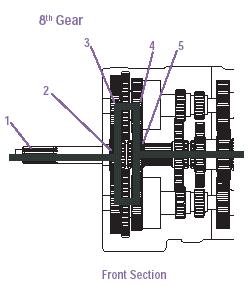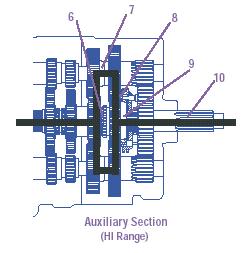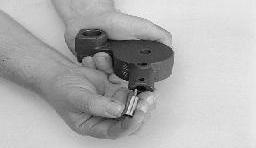
3 minute read
Power Flow
The transmission must efficiently transfer the engine's power to the vehicle's driveline. Knowledge of what takes place in the transmission is helpful when troubleshooting and making repairs.
1st Gear
• Power (torque) from the vehicle's engine is transferred to the transmission's input shaft.(1) • The input shaft external splines engage the main drive gear internal splines.(2) • Torque is split between the two countershaft drive gears.(3) • Torque is delivered along both countershafts to the mating countershaft gears of the "engaged" mainshaft gear. The following cross section view illustrates a 1st speed gear engagement.(4) • The external clutching teeth of the sliding clutch engage with the internal clutching teeth of the mainshaft gear which transfers torque to the mainshaft.(5)
• The mainshaft transfers torque directly to the rear auxiliary drive gear sliding clutch which is in the rearward position.(6) • The rear auxiliary drive gear splits torque between the two auxiliary countershaft drive gears.(7) • Torque is delivered along both countershafts to the LO range gear in the auxiliary section.(8) • The LO range gear delivers torque to the output shaft through the range synchronizer sliding clutch.(9) • The output shaft delivers torque to the driveline components.(10)

2nd Gear
• Power (torque) from the vehicle's engine is transferred to the transmission's input shaft.(1) • The input shaft external splines engage the main drive gear internal splines.(2) • Torque is split between the two countershaft drive gears.(3) • Torque is delivered along both countershafts to the mating countershaft gears of the "engaged" mainshaft gear. The following cross section view illustrates a 2nd speed gear engagement.(4) • The external clutching teeth of the sliding clutch engage with the internal clutching teeth of the mainshaft gear which transfers torque to the mainshaft.(5)
• The mainshaft transfers torque directly to the auxiliary drive gear sliding clutch which is in the forward position.(6) • The auxiliary drive gear splits torque between the two auxiliary countershaft drive gears.(7) • Torque is delivered along both countershafts to the LO range gear in the auxiliary section.(8) • The LO range gear delivers torque to the output shaft through the range synchronizer sliding clutch.(9) • The output shaft delivers torque to the driveline components.(10)
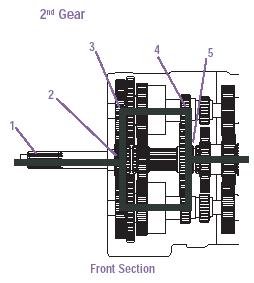
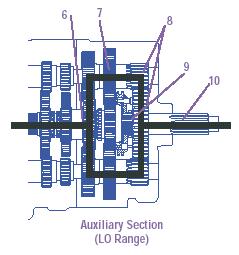
7th gear
• Power (torque) from the vehicle's engine is transferred to the transmission's input shaft.(1) • The input shaft external splines engage the main drive gear internal splines.(2) • Torque is split between the two countershaft drive gears.(3) • Torque is delivered along both countershafts to the mating countershaft gears of the "engaged" mainshaft gear. The following cross section view illustrates a 7th speed gear engagement.(4) • The external clutching teeth of the sliding clutch engage with the internal clutching teeth of the mainshaft gear which transfers torque to the mainshaft.(5)
• The mainshaft transfers torque directly to the rear auxiliary drive gear sliding clutch which is in the rearward position.(6) • Torque is delivered to the back of the rear auxiliary drive gear. The range synchronizer sliding clutch is in the forward position, transferring torque directly to the output shaft.(7) • The output shaft delivers torque to the driveline components.(8)
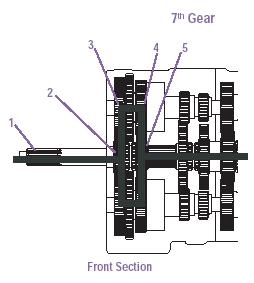

8th Gear
• Power (torque) from the vehicle's engine is transferred to the transmission's input shaft.(1) • The input shaft external splines engage the main drive gear internal splines.(2) • Torque is split between the two countershaft drive gears.(3) • Torque is delivered along both countershafts to the mating countershaft gears of the "engaged" mainshaft gear. The following cross section view illustrates a 8th speed gear engagement.(4) • The external clutching teeth of the sliding clutch engage with the internal clutching teeth of the mainshaft gear which transfers torque to the mainshaft.(5)
• The mainshaft transfers torque directly to the front auxiliary drive gear sliding clutch which is in the forward position.(6) • The front auxiliary drive gear splits torque between the two auxiliary countershaft drive gears.(7) • Torque is delivered along both countershafts to the rear auxiliary drive gear.(8) • Torque is transferred to the range synchronizer sliding clutch which is in the forward position delivering torque directly to the output shaft.(9) • The output shaft delivers torque to the driveline components.(10)
